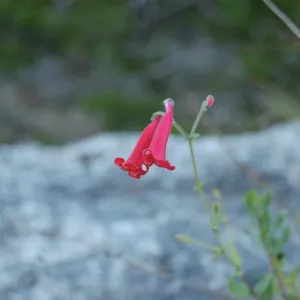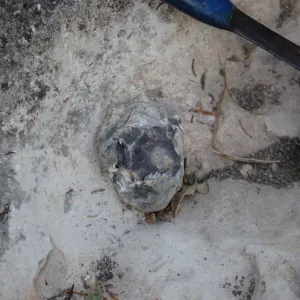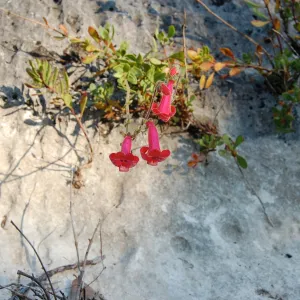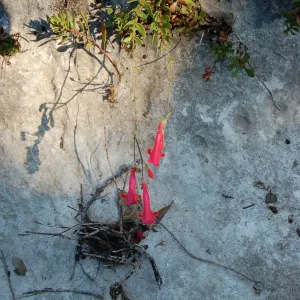By Delmar Cain – Boerne Chapter, Native Plant Society of Texas
Published in the Boerne Star on May 9, 2014

This year is going by quickly and it is May already. It is also time for the Boerne Chapter of the Native Plant Society of Texas to recommend a NICE (Native Instead of Common Exotic) plant for the month for May. The featured plant for this moth is the Rock Penstemon (Penstemon baccharifolius). It has a flower that is an eye-catcher but the plant is no wimp.
I first saw this plant in 2007. An artist, Diane Avis, was spending time in Texas at a ranch on the Medina River near Pipe Creek, called Fred’s Place. Somehow she got my name and asked if I would come to the ranch and tell her the name of some of the plants and birds. I met her at the ranch and did a quick survey of a limestone canyon that told me that I needed more expertise than the person wearing my hat that day. I did see one plant, growing more or less out of a rock, that I certainly wanted to identify.
I knew that Bill Ward was always up for a field trip to different property, especially if it involved a canyon and the potential for finding another stand of Big Red Sage. The only persuasion that Bill needed was an invitation and an empty space on his calendar.
So on a beautiful fall day in late October, Bill and I headed west on SH 46. When we got to the ranch and the obligatory greetings and chitchat were completed, we headed to the middle of the property where a dry limestone creek bed suddenly and dramatically dropped into a medium sized Hill Country canyon.
Seeing Bill and that limestone canyon reminded me of that day in Austin when our miniature schnauzer, an inside couch dog, chased, caught and killed a mouse. This was what he was meant to do—this was his purpose in being. What that mouse was to our schnauzer, that limestone canyon was to Bill.

Without any hesitation Bill broke through the old ashe junipers, went over the side and scrambled down through the vines to the bottom of the canyon. Through the rest of the exploration that day, Bill leaned over rocks, tasted of rocks, climbed up the sides of steep outcrops and examined plants and fossils with his hand lens. His chisel-tip rock hammer got a good workout. Bill got a thrill exploring the canyon and I got a kick watching Bill.

We were rewarded also by seeing canyon mock-orange, false indigo, rusty blackhaw and some of the prettiest Lacey oaks that I have seen. We were serenaded and fussed at by a canyon wren and spied on by a red-shouldered hawk. A black vulture sailed by occasionally to make sure we were still moving. We did not find Big Red Sage, but we did find Rock Penstemon hanging precariously from the rocks.
Rock Penstemon, also known as Cut-Leaf Penstemon, Baccharis-leaf Beardtongue and Beard Tongue grows natively in the Edwards Plateau, the eastern counties of the Trans-Pecos and into Mexico. It is not documented in the USDA Plant Database in Medina County, but that is where Bill and I found it.
I have never seen a penstemon that I did not appreciate. The Rock Penstemon is not an exception. Its leaves are opposite on the stem and have a thickened almost rubbery appearance. Some of the leaves may be toothed around the edges and others may be smooth. The plant can grow to two feet in height, but will be reclining on a rocky site.

Its blooms are scarlet or cherry red and shaped like tiny megaphones with lips on the larger end. The flowers have a bit of white on the inner side of the lips, and are arranged on long stems that grow from the axils of the topmost leaves.
Rock Penstemon is found in dry, rocky environments and grows best in those conditions. It will grow in full sun and in part shade. It needs excellent drainage and can be planted in limestone based rock, gravel or sandy soil. If it is planted in soil, consider placing a nice limestone rock nearby for good measure. Detailed planting instructions are given on the Boerne Chapter NPSOT website under Plant of the Month at: http://www.npsot.org/wp/boerne/
Protect your Rock Penstemon from the deer. It will also attract hummingbirds and bees. Its flowers will provide you with viewing pleasure from June into September. Those flowers growing out of the limestone bluff at Fred’s Place were part of a wonderful memory from October of 2007.
